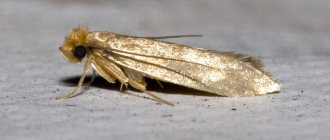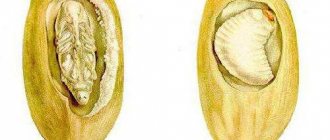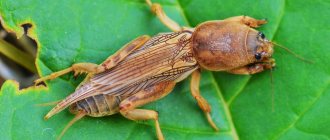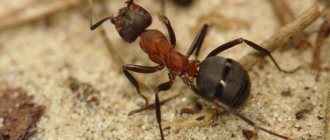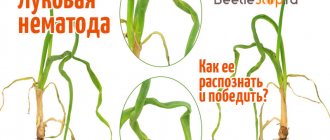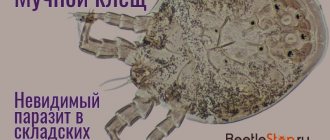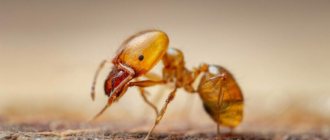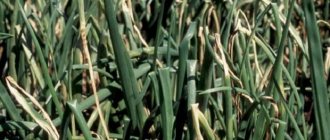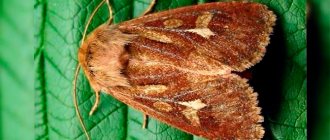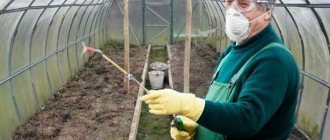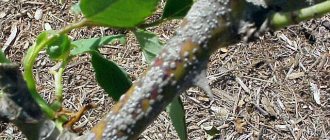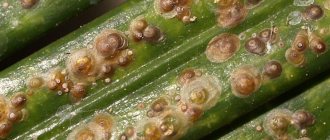As you know, if last year a plum gave a rich harvest, this year it will rest. This is due to the loss of most of the nutrients that the plant spent on the formation of juicy fruits. And there are very few of them left, but quite enough for several new shoots to form and buds to form. It is during this period that plums are weakened and therefore most susceptible to attacks by various pests. And one of them is the plum moth, which can significantly reduce the quality and affect the quantitative indicators of the future harvest.
Plum moth: what kind of pest
This pest belongs to the crepuscular species of insects, that is, it becomes active at dusk, as well as at night at temperatures from + 16 degrees.
The insect affects not only plums, but also cherry plums, peaches, and sometimes cherries.
External description
Codling moth butterflies have a gray tint with a purple tint. The length of its body with wings is about 1.7 cm. The main activity of butterflies takes place in the evening and at night; it is difficult to notice them during the day. They lay their eggs on the lower part of the leaves of any stone fruit tree. The appearance of such butterflies in the garden is a signal that urgent measures must be taken to save the harvest and the trees themselves.
Life cycle
The larvae overwinter under the bark of trees or in the top layer of soil. In spring, overwintered pupae turn into butterflies. The butterfly lives for two weeks. The first ones appear during the flowering period. By the end of the period, their number increases significantly.
They lay eggs (up to 40 pieces) at the site of fruit ovary, then caterpillars emerge from there.
Caterpillars develop in eggs in about 10-12 days. At cool temperatures this period may be delayed. They then emerge from the eggs. The caterpillars are bright red, about 1.5 cm long. They live on average up to 45 days. During this period, they cause significant damage to trees.
Agrotechnical methods
The timing of agricultural work aimed at preventing the mass appearance of pests is early spring and late autumn. First of all, they maintain cleanliness under the trees, regularly removing fallen leaves, twigs, and carrion. In the spring, the trunks are cleared of pieces of dead bark - it is under this that a significant part of the larvae overwinter, and whitewashing is carried out.
Ways to control insects
To effectively fight insects, you can use not only chemicals, but also natural remedies that are completely safe for both humans and plants in the garden. There are several ways to get rid of the codling moth.
See also
Reasons why plum trees do not bear fruit and what to do about it
Read
Pheromone traps
Recently, a similar method of getting rid of pests has been used by gardeners quite often. The pungent odor used in such devices attracts male codling moths. Butterflies end up in such a trap, but cannot get out of there. As a result, females are unable to lay eggs. The devices are hung at the rate of 1 piece per 4 trees. Traps are valid for up to 2 months.
Chemicals
Chemical preparations most effectively cope with insects at any stage of development. It is important to follow the processing rules recommended by the manufacturer in the instructions. If the gardener also uses mechanical and agrotechnical methods, the pests will disappear quickly and the harvest will be preserved.
It should be remembered that excessive use of chemicals should be avoided, as the reagents contained in the drugs. capable of accumulating in fruits.
Bitoxibacillin
Such a microbial preparation based on bacteria can effectively destroy the codling moth in the garden plot. The number of sprays can be from 2 to 5 times with an interval of about 10 days. The product is available in the form of a powder, placed in a sachet, 20 g each. Before use, 100 ml of powder is diluted in 10 liters of water. The resulting solution is sprayed onto the plants.
Sumi-Alpha
A synthetic product produced in Japan. It is produced in the form of an emulsion. The drug has a wide spectrum of action against most pests of garden crops. The period of protective action is 20 days, then, if necessary, the treatment of plants can be repeated.
Iskra-M
This preparation is based on a microorganic complex that is safe for humans and harmful to the codling moth and its larvae. Spraying is carried out twice: during the flowering period, and then 7 days after the first time. If there is a large concentration of caterpillars, the procedure is repeated 3-4 more times during the summer period.
Ivanhoe
This product is used to treat trees during their growing season. The active substance of the drug is in an amount sufficient to kill insects, including codling moths. The working solution is prepared in accordance with the manufacturer's instructions.
Biological methods
A combination of biological measures and chemicals will help you successfully control pests. In some cases, it is necessary to use only drugs of direct biological action, since they are completely safe for humans and plants.
Trichogramma are tiny organisms that settle on insect eggs and parasitize them, simultaneously destroying them.
This method is often used on an industrial scale. It is important to remove damaged shoots and fruits.
A good way to combat this would be to attract birds to your garden plot.
Mechanical and agrotechnical techniques
Such methods will increase the effectiveness of other means. After harvesting, be sure to dig up the soil in the circle around the trunk and remove fallen leaves, since codling moth pupae hide in it for the winter. The trees must be shaken so that the remaining fruits fall from them. It is very important to promptly remove carrion from the garden and destroy it.
See also
Description and technology of growing plum variety Red Ball
Read
Folk remedies
It is important to combat the codling moth in neighboring areas as well. Only in this case can the desired result be achieved. Summer residents often use light traps to catch butterflies, as well as adhesive paper belts placed on tree trunks. These devices check daily for captured caterpillars and butterflies and dispose of them. Folk remedies are successfully used by gardeners on their personal plots.
Tomato infusion
An excellent remedy is treating trees with infusion of tomato tops. Roots and green tomatoes will also be used in the decoction. For every 2 kg of plant parts you will need 5 liters of water. To treat 3 liters of such a decoction, dilute 10 liters of water and add 50 g. With the resulting liquid, you need to carefully treat the trees not only on your site, but also on neighboring ones.
Pepper infusion
To prepare such a remedy, pour 6-7 pods of hot pepper into 2 liters of water and boil for at least 2 hours. This liquid is infused for 2 days. The resulting liquid should be filtered. To spray plants, it is diluted with water (10 liters for every 0.5 liter of infusion). Immediately before treating the trees, add 50 g of crushed soap to the solution.
Tobacco liquid
To prepare such a decoction, take half a kilo of dry tobacco and 50 g of laundry soap per 20 liters of water. First, tobacco is filled with half the normal amount of water for 2 days, then the remaining water is added. Before spraying, add crushed soap. Infusions of pine needles, delphinium, wormwood, tansy and other herbs are also used. The tree is sprayed with such liquids every 7 days.
How to do without chemicals
Plum pests
Some gardeners decide to abandon the use of chemicals. Is it possible? Prevention will help reduce the number of plum moths.
To do this, the following measures are taken:
- Dead bark is removed from the trunks. After all, she can stay under it for the winter.
- It is advisable to regularly burn waste on the site, including fallen and spoiled fruit on the ground.
- The larvae are caught with adhesive strips of cardboard or burlap placed at the bottom of the trunk. A special glue is used that does not dry out. This procedure is performed after flowering. The belt is changed as needed.
- Trichogramma (microscopic insects) are used for control. They are released when the codling moth lays eggs, which are then affected.
- Systematically prune shoots affected by the pest.
- They attract birds by making houses.
- During pupation, the soil near the tree is loosened every ten days, which prevents crawling.
- They make pheromone traps with the scents of female moths. Males are captured. One such device is enough for 4 trees.
- Spray with infusions of tansy, tomato or potato tops, chamomile, and burdock, treating with the compounds weekly. This is a folk method.
- Water with ash and soap is also a means of treatment.
All these methods are used in turn. If they don't help, use chemicals. Knowing how to deal with the pest - the codling moth on a plum, apple or cherry tree, the gardener will be able to take action in advance and protect the crop.
5 1 vote
Article rating
Timing and technology of tree processing
The first treatment with insecticides is carried out in the first half of May. From mid-July to August, areas see the greatest concentrations of caterpillars, so it is important to spray trees at least twice during this time.
The codling moth can occur more than once during the summer, so one-time control measures will not be enough.
Plants are treated in dry weather. You should choose days for spraying that there is no wind. In the fight against this insect, it is important to treat not only your own, but also neighboring garden plots.
Types of ticks
Gall and red fruit mites have a bright red body color. The first representative is capable of forming numerous growths and the beginning of shoots. Small parasites are located in them in winter, when the air temperature is 15 degrees. In early spring, it actively feeds on young shoots. During the summer period, 3 generations of ticks can degenerate. The presence of cobwebs on the plum indicates insect activity. Thanks to it, ticks travel from one tree to another.
The larvae prefer to feed on plant sap. Insufficient levels of nutrients in the fruits and stems of the plant affect the health of the fruit tree. As a result, it begins to lose leaves and juicy fruits. In hot summer, on the back of the leaf you can see numerous egg clutches, inside which young parasites develop.
